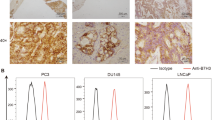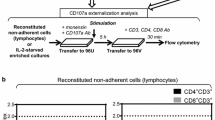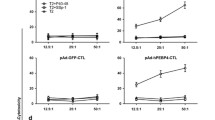Abstract
STEAP is a recently identified protein shown to be particularly overexpressed in prostate cancer and also present in numerous human cancer cell lines from prostate, pancreas, colon, breast, testicular, cervical, bladder and ovarian carcinoma, acute lymphocytic leukemia and Ewing sarcoma. This expression profile renders STEAP an appealing candidate for broad cancer immunotherapy. In order to investigate if STEAP is a tumor antigen that can be targeted by specific CD8+ T cells, we identified two high affinity HLA-A*0201 restricted peptides (STEAP86–94 and STEAP262–270). These peptides were immunogenic in vivo in HLA-A*0201 transgenic HHD mice. Peptide specific murine CD8 T cells recognized COS-7 cells co-transfected with HHD (HLA-A*0201) and STEAP cDNA constructs and also HLA-A*0201+ STEAP+ human tumor cells. Furthermore, STEAP86–94 and STEAP262–270 stimulated specific CD8+ T cells from HLA-A*0201+ healthy donors, and these peptide specific CD8+ T cells recognized STEAP positive human tumor cells in an HLA-A*0201-restricted manner. Importantly, STEAP86–94-specific T cells were detected and reactive in the peripheral blood mononuclear cells in NSCLC and prostate cancer patients ex vivo. These results show that STEAP can be a target of anti-tumor CD8+ T cells and that STEAP peptides can be used for a broad-spectrum-tumor immunotherapy.



Similar content being viewed by others
References
Alves PM, Faure O, Graff-Dubois S, Gross DA, Cornet S, Chouaib S, Miconnet I, Lemonnier FA, Kosmatopoulos K (2003) Epha2 as target of anticancer immunotherapy: identification of HLA-A*0201-restricted epitopes. Cancer Res 63:8476–8480
Andersen MH, Pedersen LO, Becker JC, Straten PT (2001) Identification of a cytotoxic T lymphocyte response to the apoptosis inhibitor protein survivin in cancer patients. Cancer Res 61:869–872
Bai XF, Liu J, Li O, Zheng P, Liu Y (2003) Antigenic drift as a mechanism for tumor evasion of destruction by cytolytic T lymphocytes. J Clin Invest 111:1487–1496
Boon T, Cerottini JC, Van den Eynde B, van der Bruggen P, Van Pel A (1994) Tumor antigens recognized by T lymphocytes. Annu Rev Immunol 12:337–365
Chen CH, Wu TC (1998) Experimental vaccine strategies for cancer immunotherapy. J Biomed Sci 5:231–252
Cornet S, Miconnet I, Menez-Jamet J, Lemonnier FA, Kosmatopoulos K (2006) Optimal organization of a polypeptide-based candidate cancer vaccine composed of cryptic tumor peptides with enhanced immunogenicity. Vaccine 24:2102–2109
Espevik T, Nissen-Meyer J (1986) A highly sensitive cell line, Wehi 164 Clone 13, for measuring cytotoxic factor/tumor necrosis factor from human monocytes. J Immunol Methods 95:99–105
Faure O, Graff-Dubois S, Bretaudeau L, Derre L, Gross DA, Alves PM, Cornet S, Duffour MT, Chouaib S, Miconnet I, Gregoire M, Jotereau F, Lemonnier FA, Abastado JP, Kosmatopoulos K (2004) Inducible Hsp70 as target of anticancer immunotherapy: identification of HLA-A*0201-restricted epitopes. Int J Cancer 108:863–870
Foss FM (2002) Immunologic mechanisms of antitumor activity. Semin Oncol 29:5–11
Garcia KC, Teyton L, Wilson IA (1999) Structural basis of T cell recognition. Annu Rev Immunol 17:369–397
Graff-Dubois S, Faure O, Gross DA, Alves P, Scardino A, Chouaib S, Lemonnier FA, Kosmatopoulos K (2002) Generation of CTL recognizing an HLA-A*0201-restricted epitope shared by Mage-A1, -A2, -A3, -A4, -A6, -A10, and -A12 tumor antigens: implication in a broad-spectrum tumor immunotherapy. J Immunol 169:575–580
Hubert RS, Vivanco I, Chen E, Rastegar S, Leong K, Mitchell SC, Madraswala R, Zhou Y, Kuo J, Raitano AB, Jakobovits A, Saffran DC, Afar DE (1999) STEAP: a prostate-specific cell-surface antigen highly expressed in human prostate tumors. Proc Natl Acad Sci USA 96:14523–14528
Jung T, Schauer U, Heusser C, Neumann C, Rieger C (1993) Detection of intracellular cytokines by flow cytometry. J Immunol Methods 159:197–207
Machlenkin A, Paz A, Bar Haim E, Goldberger O, Finkel E, Tirosh B, Volovitz I, Vadai E, Lugassy G, Cytron S, Lemonnier F, Tzehoval E, Eisenbach L (2005) Human CTL epitopes prostatic acid phosphatase-3 and six-transmembrane epithelial antigen of prostate-3 as candidates for prostate cancer immunotherapy. Cancer Res 65:6435–6442
Melief CJ, Toes RE, Medema JP, van der Burg SH, Ossendorp F, Offringa R (2000) Strategies for immunotherapy of cancer. Adv Immunol 75:235–282
Morgan DJ, Kreuwel HT, Fleck S, Levitsky HI, Pardoll DM, Sherman LA (1998) Activation of low avidity CTL specific for a self epitope results in tumor rejection but not autoimmunity. J Immunol 160:643–651
Parham P, Brodsky FM (1981) Partial purification and some properties of BB7.2. A cytotoxic monoclonal antibody with specificity for HLA-A2 and a variant of HLA-A28. Hum Immunol 3:277–299
Parker KC, Bednarek MA, Coligan JE (1994) Scheme for ranking potential HLA-A2 binding peptides based on independent binding of individual peptide side-chains. J Immunol 152:163–175
Pascolo S, Bervas N, Ure JM, Smith AG, Lemonnier FA, Perarnau B (1997) HLA-A2.1-restricted education and cytolytic activity of CD8(+) T lymphocytes from beta2 microglobulin (beta2m) HLA-A2.1 monochain transgenic H-2Db beta2m double knockout mice. J Exp Med 185:2043–2051
Rammensee H, Bachmann J, Emmerich NP, Bachor OA, Stevanovic S (1999) SYFPEITHI: database for MHC ligands and peptide motifs. Immunogenetics 50:213–219
Ressing ME, Offringa R, Toes RE, Ossendorp F, de Jong JH, Brandt RM, Kast WM, Melief CJ (1996) Immunotherapy of cancer by peptide-based vaccines for the induction of tumor-specific T cell immunity. Immunotechnology 2:241–251
Rodeberg DA, Nuss RA, Elsawa SF, Celis E (2005) Recognition of six-transmembrane epithelial antigen of the prostate-expressing tumor cells by peptide antigen-induced cytotoxic T lymphocytes. Clin Cancer Res 11:4545–4542
Rudolph MG, Wilson IA (2002) The specificity of TCR/pMHC interaction. Curr Opin Immunol 14:52–65
Scardino A, Alves P, Gross DA, Tourdot S, Graff-Dubois S, Angevin E, Firat H, Chouaib S, Lemonnier F, Nadler LM, Cardoso AA, Kosmatopoulos K (2001) Identification of HER-2/Neu immunogenic epitopes presented by renal cell carcinoma and other human epithelial tumors. Eur J Immunol 31:3261–3270
Schmitz M, Diestelkoetter P, Weigle B, Schmachtenberg F, Stevanovic S, Ockert D, Rammensee HG, Rieber EP (2000) Generation of survivin-specific CD8+ T effector cells by dendritic cells pulsed with protein or selected peptides. Cancer Res 60:4845–4849
Theobald M, Biggs J, Hernandez J, Lustgarten J, Labadie C, Sherman LA (1997) Tolerance to p53 by A2.1-restricted cytotoxic T lymphocytes. J Exp Med 185:833–841
Tourdot S, Scardino A, Saloustrou E, Gross DA, Pascolo S, Cordopatis P, Lemonnier FA, Kosmatopoulos K (2000) A general strategy to enhance immunogenicity of low-affinity HLA-A2. 1-Associated peptides: implication in the identification of cryptic tumor epitopes. Eur J Immunol 30:3411–3421
Vonderheide RH, Hahn WC, Schultze JL, Nadler LM (1999) The telomerase catalytic subunit is a widely expressed tumor-associated antigen recognized by cytotoxic T lymphocytes. Immunity 10:673–679
Yang D, Holt GE, Velders MP, Kwon ED, Kast WM (2001) Murine six-transmembrane epithelial antigen of the prostate, prostate stem cell antigen, and prostate-specific membrane antigen: prostate-specific cell-surface antigens highly expressed in prostate cancer of transgenic adenocarcinoma mouse prostate mice. Cancer Res 61:5857–5860
Acknowledgments
We thank Dr. Francine Jotereau (Inserm U463, Nantes, France) for providing tumor cell lines used in this study. This work was supported by grants from the INSERM (PROGRES), the Ligue Nationale contre le Cancer (Comité de Paris) and the Association pour la Recherche contre le Cancer (ARC #5129). PMSA is a fellow of the Fundação para a Ciência e a Tecnologia (PRAXIS XXI/BD/11252/97)—Portugal and ARC(ML/MLD/CM-A01/1). PMSA is a student of Oporto University’s GABBA (Programa Graduado em Biologia Básica e Aplicada) program, Portugal. OF is a fellow of the Association Nationale de la Recherche Technique (ANRT).
Author information
Authors and Affiliations
Corresponding author
Rights and permissions
About this article
Cite this article
Alves, P.M.S., Faure, O., Graff-Dubois, S. et al. STEAP, a prostate tumor antigen, is a target of human CD8+ T cells. Cancer Immunol Immunother 55, 1515–1523 (2006). https://doi.org/10.1007/s00262-006-0165-3
Received:
Accepted:
Published:
Issue Date:
DOI: https://doi.org/10.1007/s00262-006-0165-3




